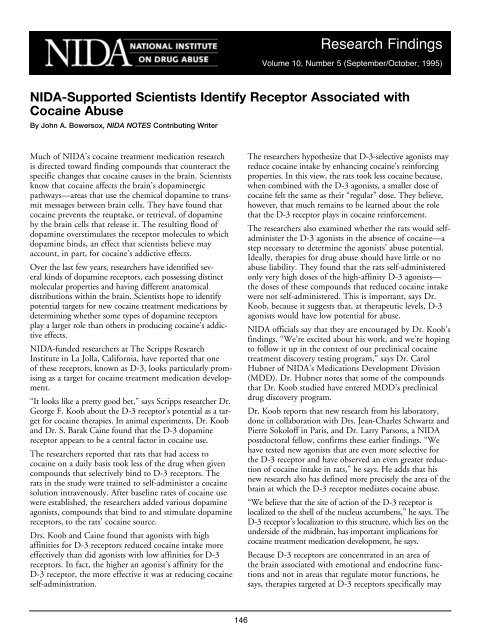Research on Cocaine - Archives - National Institute on Drug Abuse
Research on Cocaine - Archives - National Institute on Drug Abuse
Research on Cocaine - Archives - National Institute on Drug Abuse
Create successful ePaper yourself
Turn your PDF publications into a flip-book with our unique Google optimized e-Paper software.
146<br />
<str<strong>on</strong>g>Research</str<strong>on</strong>g> Findings<br />
NIDA-Supported Scientists Identify Receptor Associated with<br />
<strong>Cocaine</strong> <strong>Abuse</strong><br />
By John A. Bowersox, NIDA Notes C<strong>on</strong>tributing Writer<br />
Much of NIDA’s cocaine treatment medicati<strong>on</strong> research<br />
is directed toward finding compounds that counteract the<br />
specific changes that cocaine causes in the brain. Scientists<br />
know that cocaine affects the brain’s dopaminergic<br />
pathways—areas that use the chemical dopamine to transmit<br />
messages between brain cells. They have found that<br />
cocaine prevents the reuptake, or retrieval, of dopamine<br />
by the brain cells that release it. The resulting flood of<br />
dopamine overstimulates the receptor molecules to which<br />
dopamine binds, an effect that scientists believe may<br />
account, in part, for cocaine’s addictive effects.<br />
Over the last few years, researchers have identified several<br />
kinds of dopamine receptors, each possessing distinct<br />
molecular properties and having different anatomical<br />
distributi<strong>on</strong>s within the brain. Scientists hope to identify<br />
potential targets for new cocaine treatment medicati<strong>on</strong>s by<br />
determining whether some types of dopamine receptors<br />
play a larger role than others in producing cocaine’s addictive<br />
effects.<br />
NIDA-funded researchers at The Scripps <str<strong>on</strong>g>Research</str<strong>on</strong>g><br />
<strong>Institute</strong> in La Jolla, California, have reported that <strong>on</strong>e<br />
of these receptors, known as D-3, looks particularly promising<br />
as a target for cocaine treatment medicati<strong>on</strong> development.<br />
“It looks like a pretty good bet,” says Scripps researcher Dr.<br />
George F. Koob about the D-3 receptor’s potential as a target<br />
for cocaine therapies. In animal experiments, Dr. Koob<br />
and Dr. S. Barak Caine found that the D-3 dopamine<br />
receptor appears to be a central factor in cocaine use.<br />
The researchers reported that rats that had access to<br />
cocaine <strong>on</strong> a daily basis took less of the drug when given<br />
compounds that selectively bind to D-3 receptors. The<br />
rats in the study were trained to self-administer a cocaine<br />
soluti<strong>on</strong> intravenously. After baseline rates of cocaine use<br />
were established, the researchers added various dopamine<br />
ag<strong>on</strong>ists, compounds that bind to and stimulate dopamine<br />
receptors, to the rats’ cocaine source.<br />
Drs. Koob and Caine found that ag<strong>on</strong>ists with high<br />
affinities for D-3 receptors reduced cocaine intake more<br />
effectively than did ag<strong>on</strong>ists with low affinities for D-3<br />
receptors. In fact, the higher an ag<strong>on</strong>ist’s affinity for the<br />
D-3 receptor, the more effective it was at reducing cocaine<br />
self-administrati<strong>on</strong>.<br />
Volume 10, Number 5 (September/October, 1995)<br />
The researchers hypothesize that D-3-selective ag<strong>on</strong>ists may<br />
reduce cocaine intake by enhancing cocaine’s reinforcing<br />
properties. In this view, the rats took less cocaine because,<br />
when combined with the D-3 ag<strong>on</strong>ists, a smaller dose of<br />
cocaine felt the same as their “regular” dose. They believe,<br />
however, that much remains to be learned about the role<br />
that the D-3 receptor plays in cocaine reinforcement.<br />
The researchers also examined whether the rats would selfadminister<br />
the D-3 ag<strong>on</strong>ists in the absence of cocaine—a<br />
step necessary to determine the ag<strong>on</strong>ists’ abuse potential.<br />
Ideally, therapies for drug abuse should have little or no<br />
abuse liability. They found that the rats self-administered<br />
<strong>on</strong>ly very high doses of the high-affinity D-3 ag<strong>on</strong>ists—<br />
the doses of these compounds that reduced cocaine intake<br />
were not self-administered. This is important, says Dr.<br />
Koob, because it suggests that, at therapeutic levels, D-3<br />
ag<strong>on</strong>ists would have low potential for abuse.<br />
NIDA officials say that they are encouraged by Dr. Koob’s<br />
findings. “We’re excited about his work, and we’re hoping<br />
to follow it up in the c<strong>on</strong>text of our preclinical cocaine<br />
treatment discovery testing program,” says Dr. Carol<br />
Hubner of NIDA’s Medicati<strong>on</strong>s Development Divisi<strong>on</strong><br />
(MDD). Dr. Hubner notes that some of the compounds<br />
that Dr. Koob studied have entered MDD’s preclinical<br />
drug discovery program.<br />
Dr. Koob reports that new research from his laboratory,<br />
d<strong>on</strong>e in collaborati<strong>on</strong> with Drs. Jean-Charles Schwartz and<br />
Pierre Sokoloff in Paris, and Dr. Larry Pars<strong>on</strong>s, a NIDA<br />
postdoctoral fellow, c<strong>on</strong>firms these earlier findings. “We<br />
have tested new ag<strong>on</strong>ists that are even more selective for<br />
the D-3 receptor and have observed an even greater reducti<strong>on</strong><br />
of cocaine intake in rats,” he says. He adds that his<br />
new research also has defined more precisely the area of the<br />
brain at which the D-3 receptor mediates cocaine abuse.<br />
“We believe that the site of acti<strong>on</strong> of the D-3 receptor is<br />
localized to the shell of the nucleus accumbens,” he says. The<br />
D-3 receptor’s localizati<strong>on</strong> to this structure, which lies <strong>on</strong> the<br />
underside of the midbrain, has important implicati<strong>on</strong>s for<br />
cocaine treatment medicati<strong>on</strong> development, he says.<br />
Because D-3 receptors are c<strong>on</strong>centrated in an area of<br />
the brain associated with emoti<strong>on</strong>al and endocrine functi<strong>on</strong>s<br />
and not in areas that regulate motor functi<strong>on</strong>s, he<br />
says, therapies targeted at D-3 receptors specifically may
















